Illustris: Unlocking Universal Secrets through Universe Simulation
Written by Maneth Perera
Our universe is a vast void filled with countless planets, stars, galaxies, and other objects. Now, through modern advances in technology, researchers are learning how to unlock the secrets of the formation of the universe. To do this, they developed a simulation of our universe called Illustris. From dark matter to galaxy clusters, today we will take a closer look at how Illustris was made and how it can tell us much more about how our universe came to be.
What is Illustris?
Illustris is a simulation of the formation of the universe and the movement of matter billions of years later, with a specific focus on galaxy formation. Illustris was completed in late 2013, and whilst new simulations have come out since then, Illustris was seen as a huge step forward for astrophysics at the time. Due to the larger scale (almost 10^10 resolution elements), the addition of extra cosmological components, and the new computing techniques used, Illustris managed to top the many simulations that came before it. The simulation was run on supercomputers in France, Germany, and the U.S., and it took a team of ten main researchers from around the world to develop it. Let’s take a closer look at some of the details about Illustris and how researchers worked to make it.
Figure 1
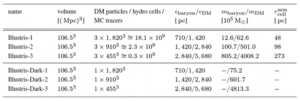
Dimensions and particle counts of different test-runs of the Illustris simulation, showing how many computing elements were generally involved.
Source: Illustris Collaboration
Cosmological Aspects: Lambda CDM Model
The Lambda CDM (Cold Dark Matter) model is an astrophysical model that posits the existence of dark matter and dark energy in order to explain the forces that interact within galaxies and between galaxies. Previous simulations that followed this model only accounted for dark matter, which is called DM simulations. Illustris is different in that it also accounts for baryonic matter.
To put it simply, dark matter is matter that doesn’t interact with light, whilst baryonic matter is matter that does. Baryonic matter is simple, everyday matter that makes up almost everything we know in the universe. We see objects in front of us because light bounces off them and hits our eyes. We don’t see glass in front of us because light passes through it whilst slowing down slightly. We see lightbulbs glow because light is emitted from them. We see some objects as black even under direct light because light is absorbed by them. All of these are examples of interactions with light.
On the other hand, dark matter is undetectable and dispersed throughout vast regions of “open” space. The ability of galaxies to hold themselves together gravitationally despite not having enough matter is attributed to extra matter from dark matter. We can’t shine lights at dark matter nor interact with it physically, making the proving of its existence extremely hard. Thus, the model remains theoretical; as we attempt to calculate more about dark matter, we create simulations to help.
Figure 2
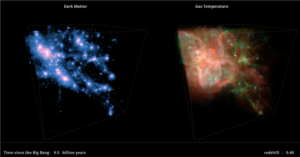
Illustris’s simulation of the temperature and dispersion of dark matter 9.5 billion years after the Big Bang.
Source: Illustris Collaboration
Previous DM simulations had a slight offset from predicted mathematical values for the Big Bang (cosmological constants, percentages of matter, speed of reactions, etc.) as well as observational values (cosmic background radiation, active galactic nuclei, etc.), and researchers hoped to use baryonic matter to make up for this offset. Illustris managed to partially account for this offset, and new simulations were built upon Illustris’s computing systems to further incorporate baryonic matter. Both types of matter play a role in the formation of galaxies and the gravitational fields generated when a galaxy forms, thus astrophysicists have turned their attention to more encompassing simulations such as Illustris. Compliance to observational values is an important quality of an accurate simulation, and is something that Illustris made large strides in.
Computational Aspects: Moving Mesh Systems
Through the four fundamental forces of gravity, the electromagnetic force, and the weak/strong nuclear forces, gravity is the one that matters the most for the universe’s formation. Since the universe rapidly expanded before cooling down and creating swirling clouds of gas, gravity must be simulated effectively to see how this process happened and how it led to galaxies.
In order to simulate the universe with 100% accuracy, one needs to look at the interactions between each and every particle. However, this obviously isn’t possible even with the most advanced computers we have today. Therefore, previous models have used different ways to simulate how particles interact.
The two most predominant ways are smoothed-particle hydrodynamics and adaptive mesh refinement. Smoothed-particle hydrodynamics defines a region of fluid (can be a gas or liquid) by where its particles are bound in a 3D shape. It then distributes the supposed mass of this gas equally among the particles. Gravitational forces are calculated for each of the particles, and the position, size, and shape of the fluid are defined by the locations of the particles. Meanwhile, adaptive mesh refinement runs these gravitational calculations on regions of space. A mesh is used to divide space into grid-like regional cubes, and gravity is calculated to act upon fluid flowing between these regions. The main difference is the calculation of gravity based on particles versus based on fluid flow between adjacent regions and the defining of fluid using particles versus using regions.
Nonetheless, Illustris uses an entirely different approach. Instead of using a rigid mesh-like adaptive mesh refinement or defining fluids with particles like smoothed-particle hydrodynamics, Illustris combines these two approaches to maximize both efficiency and accuracy when calculating astronomical fluid dynamics. Illustris creates mesh regions that change in shape and size over time depending on the flow of fluid between its neighboring cells.
To understand how this type of mesh, called a moving mesh, works, we must look at a special type of spatial tessellation: the Voronoi tessellation. Imagine a 2d plane with a random number of defined points. We aim to create regions on this plane where each region has exactly one point. To do this, we take each undefined point and check which defined point it is the closest to. We then assign that undefined point to that defined point’s region, creating lines between regions consisting of undefined points that are equidistant from two defined points. This creates regions with only one point in them, distributing space equally and achieving our initial goal.
Figure 3
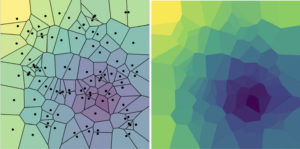
An example of a Voronoi tessellation.
Source: Built-In Data Science
Now imagine this same tessellation but in 3D space. This is what Illustris does by defining points at areas with higher fluid densities and creating regions from them. These regions then change as fluid flows around in space, allowing for faster gravitational calculations (no need to look at individual particles) and more accurate simulations (dynamic regions that better adapt to fluid flow).
Cosmological Aspects: Galactic Evolution
Illustris also aims to give us a closer look at galactic evolution for a wide array of different galaxies. Astrophysicists still aim to figure out how galaxies form in the first place, as it’s hard to get observational data. Do the black holes in the center of spiral galaxies form before or after the arms are created? How do galaxies change their shape over time?
However, we’ve already uncovered a few of the main classifications of galaxies. Spiral galaxies are adult galaxies that have a steady flow of star formation within their spiral arms and a supermassive black hole at the center, forming a bulge. Elliptical galaxies are disks with no arms, no central bulge, and a decreased rate of star formation. Lenticular galaxies are like spiral galaxies but with no arms and a decreased rate of star formation. Irregular galaxies have a wide array of shapes due to differing gravitational pulls throughout their star systems.
One of the main ways we can learn about galaxy classifications is through simulating mergers. Mergers are when two galaxies traveling through space end up colliding, forming a new galaxy with stars, gas, and dust from the original two. Mergers end up creating irregular profiles if the two original galaxies are of different types. In some cases, the gravitational pull of the center of the new galaxy can be impeded, causing galactic material to be pushed out into a ring, forming a ring-like galaxy.
Figure 4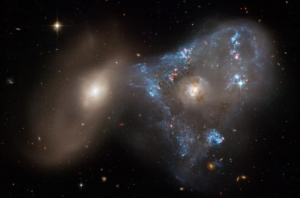
The galaxies NGC 2444 (left) and NGC 2445 (right) merged to form a triangle of younger blue stars around NGC 2445.
Source: National Aeronautics and Space Administration (NASA)
Illustris studies galactic merging in-depth to not only attempt predictions of the resulting galaxy but also to examine dark matter’s role in creating the new galaxy. Astrophysicists are still attempting to figure out how dark matter’s gravitational pull could result in certain extreme galaxy configurations we have observed so far. In addition, Illustris also looks at many other aspects of galaxies, such as galactic spectra and absorption/emission lines.
Figure 5
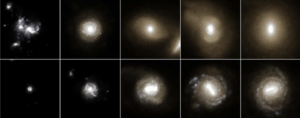
Illustris simulates the formation of a redder galaxy (top) that formed from many violent mergers of smaller galaxies and the formation of a bluer galaxy (bottom) that formed from a peaceful accumulation of gas and dust in this image.
Source: Illustris Collaboration
Cosmological Aspects: Galactic Spectra
When we shine a light through a gas cloud of a certain molecule, the wavelengths of light that are absorbed never make it through, creating black lines on the rainbow spectrum of light. The light that gets through is captured on an image, called an absorption spectrum, which shows a rainbow with black lines, called absorption lines, where certain wavelengths of light didn’t get through. The structure and properties of a galaxy can change how light moves through it and, thus, where its absorption lines are when light passes through. Certain galaxies have absorption lines that have special wavelengths, and these wavelengths are classified as the Lyman-alpha forest. Illustris researchers were able to better understand the galactic structures that lead to wavelengths in the Lyman-alpha forest, as well as more about how galaxy types influence galactic spectra.
Figure 6
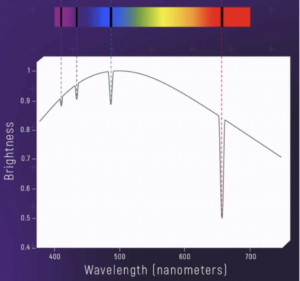
A cloud of hydrogen gas’s absorption spectrum is shown through a chart of the dips in brightness due to the absorption of those wavelengths of light.
Source: Space Telescope Science Institute (STScI)
A catalog of synthesized galaxies and their spectra from Illustris was used in multiple recent studies such as those classifying spectral energy distributions in galaxies and those looking at star formation within galaxies. By looking at galactic spectra on a large scale, we can quantify the age and structure of a galaxy, and by simulating these galactic spectra, we can visualize how these galaxies evolved over time. Additionally, the chemical composition of gas/dust clouds scattered throughout the galaxy can be read from these galactic spectra depending on the direction light travels through. Gravitational lensing and other effects on light can also indicate certain formations within a galaxy. Spectroscopy is an important field in astrophysics, and Illustris plays a large role in the simulation of it as many other studies have used Illustris’s data before.
Conclusion
The Illustris project allowed researchers to better understand our universe through specialized fluid dynamics and matter interactions. However, more and more simulations are being developed every day in the hopes of getting closer to observational quantities. Illustris was just a stop on the neverending train to explain the unexplained in astrophysics, but it was still a huge leap in simulation development and deserves the recognition it gets.
References
Bellelli, F. (2023, February 21). The Fascinating World of Voronoi Diagrams. Built-In. https://builtin.com/data-science/voronoi-diagram
National Aeronautics and Space Administration. (2024a). Evolution of Galaxies. NASA Science. https://science.nasa.gov/universe/galaxies/evolution/
National Aeronautics and Space Administration. (2024b). Types of Galaxies. NASA Science. https://science.nasa.gov/universe/galaxies/types/
The Illustris Collaboration. (n.d.). Illustris Project. Www.illustris-Project.org. Retrieved October 16, 2024, from https://www.illustris-project.org/about/
The Illustris Collaboration. (2014, May 6). Illustris Simulation: Most detailed simulation of our Universe. YouTube. https://www.youtube.com/watch?v=NjSFR40SY58